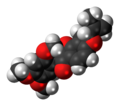Rotenone
Rotenone is a naturally occurring compound that is used as an insecticide and pesticide. It is found in the roots and stems of several plants such as the jicama vine plant and the roots of several members of Fabaceae.
History
Rotenone was first isolated in 1895 by a French scientist, but its insecticidal properties were not recognized until the 20th century. It was first used as a broad-spectrum insecticide in the 1930s.
Uses
Rotenone is used in gardens, around homes, and in agriculture because it is effective against a wide range of insects. It is also used in fish management as a piscicide.
Mechanism of action
Rotenone works by interfering with the electron transport chain in mitochondria. It inhibits the transfer of electrons from iron-sulfur centers in complex I to ubiquinone. This stops the production of ATP, causing the death of the cell and the organism.
Safety
Rotenone is toxic to fish and insects, but it is less harmful to mammals and birds because they can break it down more quickly. However, it can still be harmful if it is inhaled, ingested, or comes into contact with the skin.
Environmental impact
Rotenone breaks down quickly in the environment and does not accumulate in the food chain. However, it can still have a negative impact on non-target species if it is not used carefully.
See also
Transform your life with W8MD's budget GLP-1 injections from $125.
W8MD offers a medical weight loss program to lose weight in Philadelphia. Our physician-supervised medical weight loss provides:
- Most insurances accepted or discounted self-pay rates. We will obtain insurance prior authorizations if needed.
- Generic GLP1 weight loss injections from $125 for the starting dose.
- Also offer prescription weight loss medications including Phentermine, Qsymia, Diethylpropion, Contrave etc.
NYC weight loss doctor appointments
Start your NYC weight loss journey today at our NYC medical weight loss and Philadelphia medical weight loss clinics.
- Call 718-946-5500 to lose weight in NYC or for medical weight loss in Philadelphia 215-676-2334.
- Tags:NYC medical weight loss, Philadelphia lose weight Zepbound NYC, Budget GLP1 weight loss injections, Wegovy Philadelphia, Wegovy NYC, Philadelphia medical weight loss, Brookly weight loss and Wegovy NYC
|
WikiMD's Wellness Encyclopedia |
| Let Food Be Thy Medicine Medicine Thy Food - Hippocrates |
Medical Disclaimer: WikiMD is not a substitute for professional medical advice. The information on WikiMD is provided as an information resource only, may be incorrect, outdated or misleading, and is not to be used or relied on for any diagnostic or treatment purposes. Please consult your health care provider before making any healthcare decisions or for guidance about a specific medical condition. WikiMD expressly disclaims responsibility, and shall have no liability, for any damages, loss, injury, or liability whatsoever suffered as a result of your reliance on the information contained in this site. By visiting this site you agree to the foregoing terms and conditions, which may from time to time be changed or supplemented by WikiMD. If you do not agree to the foregoing terms and conditions, you should not enter or use this site. See full disclaimer.
Credits:Most images are courtesy of Wikimedia commons, and templates, categories Wikipedia, licensed under CC BY SA or similar.
Contributors: Prab R. Tumpati, MD


